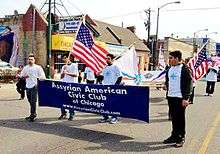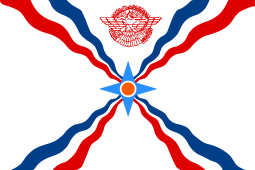Assyrian Americans
 Assyrian-Americans have a long history in Chicago; they are seen here in a protest march carrying American and Assyrian flags | |
| Total population | |
|---|---|
| 110,807–400,000[1][2][3] | |
| Regions with significant populations | |
|
| |
| Languages | |
| American English, Neo-Aramaic: 77,547[3] | |
| Religion | |
|
Mostly Assyrian Church of the East, Chaldean Catholic Church, Ancient Church of the East Some Assyrian Evangelical Church, Syriac Orthodox Church, Syriac Catholic Church, Assyrian Pentecostal Church and irreligious | |
| Related ethnic groups | |
| British Assyrians, Assyrian Australians, Assyrian Canadians |
Assyrian Americans refers to people born in or residing in the United States of full or partial Assyrian origin. The United States constitutes the largest population of Assyrian people in the Assyrian diaspora. The majority are followers of the Assyrian Church of the East, the Ancient Church of the East, the Chaldean Catholic Church and the Syriac Orthodox Church.[4]
The 2000 U.S. census counted 82,355 Assyrians in the country, of whom 42% (34,484) lived in Michigan.[5] However, Assyrian-American organizations claim that their population in 2010 is around 400,000.[6] The largest Assyrian-Chaldean diaspora is located in Metropolitan Detroit, with a figure of 100,000 as of 2007. High concentrations are also located in Chicago, Phoenix, Modesto, San Diego, Los Angeles and Turlock, among others.[7]
The first large wave of Assyrian immigration to the United States due to the Assyrian Genocide, which occurred 1914–1920. The United States is home to the third largest Assyrian community in the world.[8]
History
Assyrians have been present in the United States since the late 19th century. The first Assyrians who came to the United States were young men sent by Western missionaries for religious training.[9]
Following those years, Assyrian immigration to America mostly stopped due to the Immigration Act of 1924 which effectively cut off any legal immigration to the United States for Assyrians and other non Western European groups. Some still managed to arrive due to extended family members of immigrants coming over due to their relatives. The second large wave of Immigration occurred in the 1960s and 70s, made up mostly of Assyrians and Chaldeans from Iraq coming due to conflicts and persecution by the Baathist government of Iraq. Many Assyrians also arrived during this period to take advantage of the situation in Detroit, which was suffering from white flight.
Due to white flight, Assyrians in Detroit gained a monopoly over grocery stores and other small businesses, and in many cases used their finances and newfound wealth to benefit the Assyrian community there and take in Assyrian refugees from Iraq. More Assyrians arrived throughout the 80s and 90s for similar reasons, with newer residents moving out of Detroit into suburbs such as Royal Oak and Sterling Heights due to the Crack epidemic in Detroit, while others began to move to San Diego, establishing a new Assyrian community there.
In 2005, the first Assyrian school in the United States, the Assyrian American Christian School, opened in Tarzana, Los Angeles.
In Detroit

Assyrian Chaldean Christians immigration to the cities in Michigan began in the early 20th century. The cities in the state include, but are not limited to, Detroit, Southfield, Sterling Heights, Oak Park, Troy, West Bloomfield, Commerce, Walled Lake, Rochester Hills, Farmington Hills, Ferndale, Warren, Bloomfield Hills and Ann Arbor. More and more Assyrians-Chaldeans, as they establish themselves financially, quickly move out of Detroit and into the other locations, including San Diego and cities in Arizona.
Before the 1970s, Assyrians-Chaldeans came to the United States in search of greater economic opportunities. After the 1970s, many Assyrians fled for political freedom, especially after the rise of Saddam Hussein and, after the Persian Gulf War. Some were drawn by the economic opportunities they had seen successfully affect their family members who had already immigrated.
Less stringent immigration laws during the 1960s and 1970s facilitated increasing numbers, with the 1970s seeing the highest number of Assyrians coming to the United States. In 1962, the number of Assyrian owned grocery stores was 120, but grew to 278 in 1972. The main cause of this were the 1967 Detroit riots, after which Jewish grocery store owners left the area and left the opportunity open for Assyrians to take over. Often these Jews sold their old stores to Assyrians.[10]
Iraqi president Saddam Hussein donated hundreds of thousands of dollars to Chaldean Catholic churches in Detroit and received a key to the city in the 1980s on behalf of mayor Coleman Young, when the Baath regime was an ally of the United States government.[11]
Mostly all new Chaldean Catholic immigrants and low-income senior citizens tend to reside in Detroit, in the 7 Mile Road between Woodward Avenue and John R Street. This area was officially named Chaldean Town in 1999.[12] There are eight Chaldean Catholic churches in Metropolitan Detroit, located in West Bloomfield, Troy (where there are two), Oak Park, Southfield, Warren, Sterling Heights and Detroit.
In California
After World War II several Assyrian men who had been educated in Iraq by American Jesuits traveled to the United States. They were to teach Arabic to U.S. officers at the Army Language School who were going to be stationed in the Middle East. The men started the San Diego-area Chaldean Catholic community. Yasmeen S. Hanoosh, author of The Politics of Minority Chaldeans Between Iraq and America, wrote that the Chaldo-Assyrians in San Diego "continued to grow in relative isolation from the family-chain-migration based communities in and around Michigan."[13]
Distribution
According to the 2011 American Community Survey 1-Year Estimates there are 110,807 Assyrian people in the United States.[1][3]
Michigan
There are 26,378 living in Michigan according to the 2000 United States Census.[14]
- Sterling Heights: 5,515
- West Bloomfield: 4,874
- Southfield: 3,684
- Warren: 2,625
- Farmington Hills 2,499
- Troy: 2,047
- Detroit 1,963
- Oak Park 1,864
- Madison Heights: 1,428
- Bloomfield 513
- Hazel Park: 512
- Shelby Township: 493
- Clinton Township: 225
California
There are 22,671 living in California according to the 2000 United States Census.[15]
- The state's largest Chaldean American communities are in the San Diego area.
- Elsewhere in the Central Valley and San Francisco Bay area: San Francisco known for its several Assyrian, Chaldean and Syriac churches; Oakland and East Bay suburbs; and Santa Clara County such as San Jose.
- Other parts of Southern California, i.e. the Los Angeles area.
- Orange County.
- Inland Empire, California (Riverside-San Bernardino counties).
- The Coachella and Imperial Valleys.
Illinois
There are 34,685 living in Illinois according to the 2000 United States Census.[16]
- Chicago: 7,121
- Niles: 3,410
- Skokie
- Lincolnwood
- Morton Grove
- Maine Park: 1,035
Syriac and Syrian distinction
The U.S. federal government took the word Syrian to mean Arabs from Syria and not as one of the terms to identify the ethnically distinct Assyrians, although the terms Syrian and Syriac are accepted by mainstream majority academic opinion to be etymologically derivative of the term Assyrian,[17][18] and historically meant Assyrian.
The Syriac Orthodox Church was previously known as the Syrian Orthodox Church until a Holy Synod in 2000 voted to change it to Syriac, thus distinguishing from the Arabs. Mor Cyril Aphrem Karim wrote a letter to the Syriacs in 2000 urging them to register in the census as Syriac with a C, and not Syrian with an N to distinguish the group. He also urged them not to register as the country of origin.[19]
On the U.S. census, there is a section for the Assyrian/Chaldean/Syriacs, which is listed separately from Syrian, Syrian being a subcategory for Arab. [20]
Notable Assyrian Americans
- Adam Benjamin, Jr. , Former Politician and a United States Representative from Indiana's 1st congressional district
- Rosie Malek-Yonan, Actress, author, director, public figure and activist
- Anna Eshoo, U.S. Representative for California's 18th congressional district
- Nineveh Dinha, Former American television reporter and anchor for Fox 13
- Victor Kamber, Labor union activist and political consultant in the United States
- Vincent Oshana, Actor and comedian
- Klint Kesto, Member of the Michigan House of Representatives
- Narsai David, Author, radio and television personality in the Bay Area
- Raad Ghantous, Half-Assyrian, Half-Lebanese Interior designer
- Scott Rumana, Assyrian-American Republican Party politician
- Yasmine Hanani, Assyrian American actress
- Jumana Hanna, Imprisoned at the facility known as loose dog's during the rule of Saddam Hussein
- Janan Sawa, Assyrian musician
- Timz, Assyrian-American rapper
- Justin Meram, Footballer
- Sargon Dadesho, Campaigner, Nationalist
- Zaya Younan, Entrepreneur and real estate mogul
- Michael Shabaz, Assyrian-American tennis player
- Beneil Dariush, Assyrian-American professional mixed martial artist
- Andre Agassi, Retired professional tennis player and former World No. 1
- Daniel Alaei, professional poker player
- John Batchelor, American author and host of The John Batchelor Show radio news magazine
- Bob Miner, Former American businessman, co-founder of Oracle Corporation and the producer of Oracle's relational database management system.
- John Joseph (academic), Assyrian-American educator and historian
See also
References
- Hanoosh, Yasmeen H. The Politics of Minority Chaldeans Between Iraq and America. ProQuest, 2008. ISBN 0549984755, 9780549984757.
- Henrich, Natalie and Joseph Henrich. Why Humans Cooperate : A Cultural and Evolutionary Explanation: A Cultural and Evolutionary Explanation. Oxford University Press, May 30, 2007. ISBN 0198041179, 9780198041177.
Notes
- 1 2 Data Access and Dissemination Systems (DADS). "American FactFinder – Results". Retrieved 18 February 2015.
- ↑ "Brief History of Assyrians". Retrieved 18 February 2015.
- 1 2 3 "Selected Population Profile in the United States : 2011 American Community Survey 1-Year Estimates". Factfinder2.census.gov. Retrieved 2013-10-20.
- ↑ Alexei Krindatch. "Standing Conference of the Canonical Orthodox Bishops in the Americas" (PDF). Hartfordinstitute.org. Retrieved 2013-10-20.
- ↑ "American FactFinder". Factfinder.census.gov. Archived from the original on 5 August 2009. Retrieved 2013-10-20.
- ↑ BetBasoo, Peter. Diaspora: 1918 to present, History of Assyrians, Assyrian International News Agency (AINA).
- ↑ Henrich and Henrich, p. 81-82.
- ↑ "Chaldean Chamber of Commerce | The Chaldean American Chamber of Commerce is a partnership of Chaldean businesses and professionals working together to strengthen members' businesses, increase job opportunities, encourage expansion and promote Chaldean business and culture. The Chamber seeks to service and represent Aramaic-speaking people, including Assyrians, Chaldeans and Syriacs". Chaldeanchamber.com. 2012-05-16. Retrieved 2013-10-20.
- ↑ Ishaya, Arianne. "ASSYRIAN-AMERICANS A STUDY IN ETHNIC RECONSTRUCTION AND DISSOLUTION IN DIASPORA". www.nineveh.com. Retrieved 17 September 2014.
- ↑ Chafets, Ze'ev. Devils Night: and Other True Tales of Detroit. New York: Random House, 1990
- ↑ "March 31, 2003". Zindamagazine.com. Retrieved 2013-10-20.
- ↑ Adrian Humphreys (2 September 2011). "U.S. police foil Canada-to-Iraq luxury-car scheme". National Post. Retrieved 4 October 2014.
- ↑ Hanoosh, p. 195.
- ↑ "Census 2000 Summary File 3 (SF 3) – Sample Data: Michigan". United States Census Bureau. December 2000. Archived from the original on 2011-06-08. Retrieved 2015-12-21.
- ↑ "Census 2000 Summary File 3 (SF 3) – Sample Data: California". United States Census Bureau. December 2000. Archived from the original on 2011-06-08. Retrieved 2015-12-21.
- ↑ "Census 2000 Summary File 3 (SF 3) – Sample Data: Illinois". United States Census Bureau. December 2000. Archived from the original on 2011-06-08. Retrieved 2015-12-21.
- ↑ The Encyclopedia Americana, International ed. (c1986) Danbury, Conn.: Grolier
- ↑ Frye, R. N. (October 1992). "Assyria and Syria: Synonyms" (PDF). Journal of Near Eastern Studies 51 (4): 281–285. doi:10.1086/373570.
- ↑ "Mor Cyril Aphrem Karim – Syriac Orthodox Church of Antioch". Syrianorthodoxchurch.org. Retrieved 2013-10-20.
- ↑ "American FactFinder". Factfinder.census.gov. Retrieved 2013-10-20.
External links
- Assyrian-Americans
- Assyrian-Americans reach out to relatives displaced by Iraq war
- Chicago's Assyrian Americans

